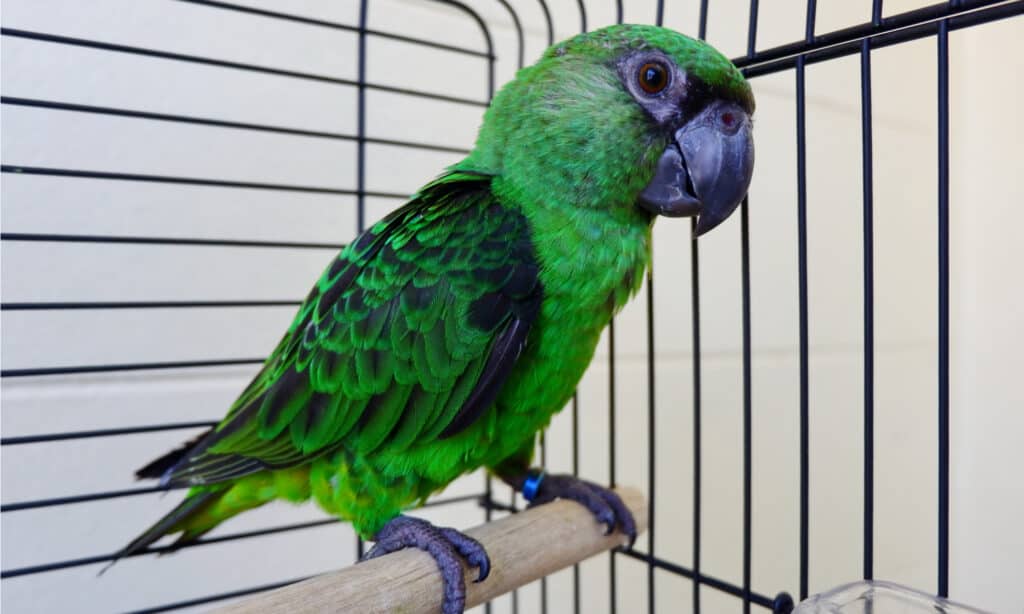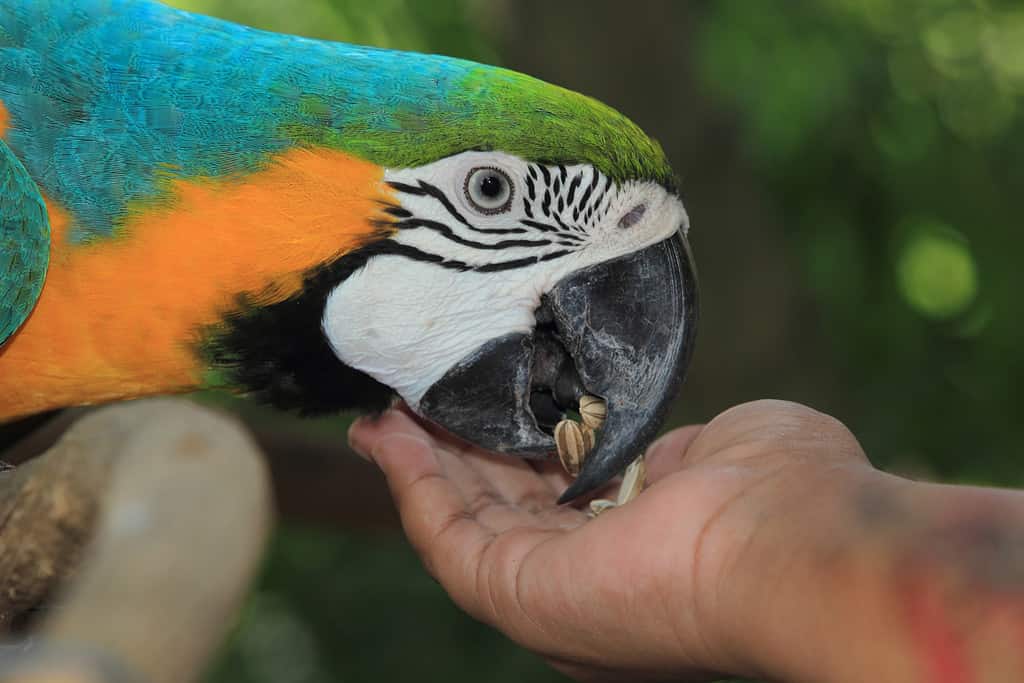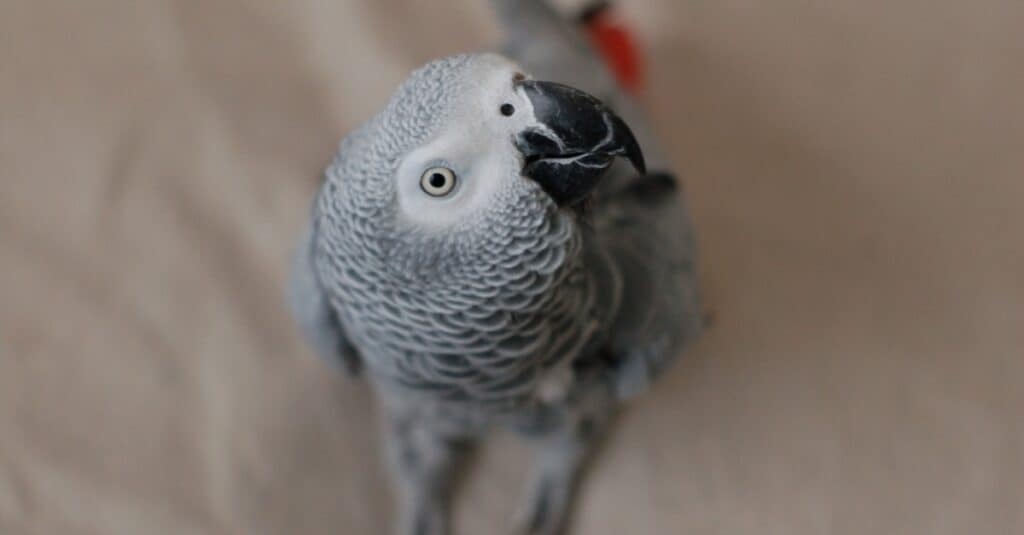Parrots are amazingly intelligent birds and great companions, but like all animals, they are wary of new surroundings and people, so it takes time to tame a parrot. However, the end result is worth it! Here’s how to tame parrots with kindness and patience.
How to Tame Parrots
The very first step in taming a parrot is managing your expectations. Every bird is different, so it could take days or even months to tame your feathery friend. Rescue parrots may need even more time, depending on the circumstances of their rehoming. Abused animals take longer to unlearn their difficult experiences and begin to trust you.
So, with your expectations set to ‘this will take lots of time,’ let’s learn how to tame parrots!

Though they are very intelligent birds, taming a parrot will take time and patience.
©TumCruise/Shutterstock.com
Getting Accustomed to Their New Home
A new arrival to your home needs to understand you are not a predator and that their new space is a safe one. Ensure they have a clean cage with plenty of food, water, and a place to hide.
For the first day or two, locate their cage in a quiet cool place so your parrot can overcome the first frights of moving into a new area. The first step to successfully taming a scared bird is removing anything that may frighten it, so you should not try to catch the parrot and lavish affection on it. Just let the newbie decompress. Only approach the cage to change the water and replace food for now.
Let Them Watch and Absorb Their New Life
After a few days, move the cage to a busier part of your home so your parrot can watch household members moving around and understand they won’t be hurt.
There are lots of new sights, sounds, and smells to process, so don’t rush this part. Let the parrot watch and grow accustomed to the newness. It takes time! Imagine you were removed from your home, housemates, family, and everything you’ve known. Patience is absolutely key.

A cage can provide your parrot with a safe place while they become accustomed to their new surroundings.
©THANYAKRIS/Shutterstock.com
Talk and Talk!
Talking to your bird in a calming voice will help him get used to you. Read a book,or the news on your cell phone,out loud next to his cage. You could try quietly singing and whistling, too.
Eat Together
In the wild, birds eat together when they feel safe, so offer him food and eat dinner where your parrot can watch. This behavior will help him feel calm.
If you want your parrot tame enough to touch. Here are the next steps.
Show of Hands
Hands are scary things for birds. A shop-bought bird will associate hands with capture and try to avoid it at all costs, so proceed slowly. Try placing your hands near the cage, resting them on its wires.
When the parrot is calm about your hands outside the cage, try moving them inside, but be wary of a nip from a frightened parrot!
Slowly put your hands in the cage and rest them there. Rest your hands in the cage for 10-15 minutes each time. Don’t grab or try to catch your parrot. Just keep your hands still. Talk to your feathery friend in a soothing voice, and don’t make any sudden movements.
Treat Time!
Once your parrot is calm with your hands in the cage, offer a treat on your outstretched palm. Eating at the same time, will help calm your bird and associate your hands with food, so he will be eager to come to you.
Offer a treat on your hand whenever food and water are replaced, and 3-4 times a day until your parrot happily takes food from your hands. It could take a while, and patience is everything.
Remember, don’t try to touch them yet. Forcing a bird into your hands will undo all your good work so far.

Once your parrot is calm around your hands, you can try offering healthy treats in the palm of your hand.
©Arnon Polin/Shutterstock.com
Stepping Onto Your Hand
When you’ve tamed a parrot so that it’s no longer afraid of your presence, you might want to consider a little more training, such as stepping onto your hand. Not all parrot parents want this. For some, it’s enough to have a chirpy friend nearby without physical contact.
However, birds are affectionate, so it’s not difficult to train a calm bird to hop on your hand.
Only try this once your bird is happy with your hands in its cage.
Approach the cage with a short stick (in a non-threatening manner!) and offer the stick to your parrot. Let him touch or grab the stick however he pleases, and offer him a treat. Do this several times a day until they are no longer afraid of the stick. Then, hold the stick in front of them horizontally just below their breastbone. When they eventually hop on, give them a treat.
Over time, replace the stick with your finger and always reinforce good behavior with a treat.
Signs of Fright
Taming a parrot takes time, and forcing your attention on a bird only makes them defensive. Here are the signs your parrot is scared. If you see them displaying these behaviors, stop what you’re doing immediately and try again later.
- Leaning away from you
- Crouching down
- Stepping away
- Flattening or sucking in feathers
Teaching a Parrot to Speak
Not all parrots can mimic human noises. The best parrots for talking are parakeets, cockatoos, macaws, and African greys. Taming them enough to say rude words to your mother-in-law (why are you looking at me!) takes a lot of time, patience, and treats!
Choose a time when your bird is calm and well-fed. Hungry birds can’t learn, they get agitated, and you get nowhere.
Once your parrot is relaxed, fed, and looking for interaction, say a simple word such as hello or your parrot’s name clearly and in a higher pitch than your usual speaking voice. Another option is to say the name of their treat as you hand it over.
Keep this up until your parrot tries to copy the word, then immediately encourage any noise they attempt to make with lots of praise. When they get the word righ, (or close enough) immediately reward them with a treat. Positive reinforcement helps build up a vocabulary of words. Parrots, especially African greys, are very clever birds that learn to speak quickly.

The African grey is one of the best talkers in the parrot family.
©iStock.com/Lilly Nonamaker
How Long Does It Take to Tame a Parrot?
It really depends on what your aim is. If you want the parrot to trust you, then shop-bought parrots usually take several weeks to feel comfortable in your presence. If you want your parrot tame enough to copy words or perform tricks, it can take months of repetitive practice.
Good Taming Treats for Parrots
Parrots are very much like toddlers. They are clever enough to learn, and they always want a snack. High-fat snacks lead to obesity and poor health though, so here are some healthy snacks you can use to tame your parrot.
- Nuts: almonds, cashews, brazils, walnuts, pine nuts, macadamias, pecans, hazelnuts, and pistachios, all unsalted with no flavorings.
- Seeds: pumpkin, sunflower, safflower, and flax.
- Veggies: asparagus, beets, carrots, broccoli, butternut, carrots, peas, corn, dandelion greens, and dark leafy greens.
- Fruits: apples, bananas, grapes, oranges, papaya, and pomegranates.
Always feed treats in moderation and ensure your parrot has plenty of nutritious main meals to fill them up.
How to Tame a Parrot: Recap
Parrots are great fun and incredible companions, but a parrot that’s afraid of its owner is an unhappy fellow. Pet parrots need lots of interaction and taming to live a happy life as your pet. The number one way to tame your parrot is with patience. Go slowly, following these steps.
- Give him several days to decompress in a quiet, safe area
- Spend time caged in a busy area of the home
- Talk, sing, and eat near your parrot
- Put your hands on the cage
- Put your hands in the cage with treats
- Once your parrot takes a treat from your hand without fear, you can move on to physical touch, but don’t rush the process. One grabbing move and you’ll undo all that hard, patient work
Give your parrot plenty of space, repeat actions gently several times a day, and they will start to trust. Of course, yummy treats will help a lot! Choose healthy, fresh treats to manage your parrot’s weight, and you’ll have a friend for life.
The photo featured at the top of this post is © iStock.com/Thirawatana Phaisalratana
Thank you for reading! Have some feedback for us? Contact the AZ Animals editorial team.






